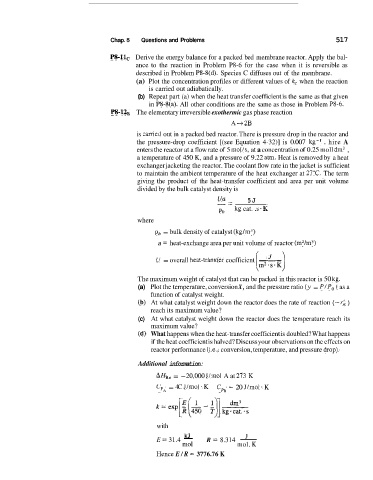Page 547 - Elements of Chemical Reaction Engineering Ebook
P. 547
Chap. I3 Questions and Problems 517
PS-& Derive the energy balance for a packed bed membrane reactor. Apply the bal-
ance to the reaction in Problem P8-6 for the case when it is reversible as
described in Problem P8-8(d). Species C diffuses out of the membrane.
(a) Plot the concentration profiles or different values of k, when the reaction
is carried out adiabatically.
(b) Repeat part (a) when the heat transfer coefficient is the same as that given
in P8-8(a). All other conditions are the same as those in Problem F'8-6.
P8-12El The elementary irreversible exothermic gas phase reaction
A+2B
is carrield out in a packed bed reactor. There is pressure drop in the reactor and
the pressure-drop coefficient [(see Equation 4-32)] is 0.007 kg-l . hire A
enters the reactor at a flow rate of 5 mol/s, at a concentration of 0.25 moll dm3 ,
a temperature of 450 K, and a pressure of 9.22 atm. Heat is removed by a heat
exchanger jacketing the reactor. The coolant flow rate in the jacket is sufficient
to maintain the ambient temperature of the heat exchanger at 27°C. The term
giving the product of the heat-transfer coefficient and area per unit volume
divided by the bulk catalyst density is
-_ 5J
ua -
Pb kg cat. . s. I([
where
Ph = bulk density of catalyst (kg/m3)
a = heat-exchange area per unit volume of reactor (m2/m3)
U = overall heat-trifnsfer coefficient -
(m2 :. K)
The maximum weight of catalyst that can be packed in this reactor is 50 kg.
(a) Plot the temperature, conversion X, and the pressure ratio (y = P/P, as a
)
function of catalyst weight.
(b) At what catalyst weight down the reactor does the rate of reaction ( -- r; )
reach its maximum value?
(c) At what catalyst weight down the reactor does the temperature reach its
maximum value?
(d) What happens when the heat-transfer coefficient is doubled? What happens
if the heat coefficient is halved? Discuss your observations on the effects on
reactor performance (Le., conversion, temperature, and pressure drop)^.
Additional information:
AHRx = -20,000 J/mol A at 273 K
Cp, = 4C J/mol* K Cp, =I 20 J/mol- K
with
J
kJ
E == 31.4 - R = 8.314 -
mol mol. K
Hence E/R = 3776.76 K

